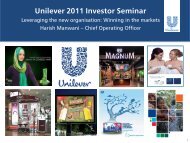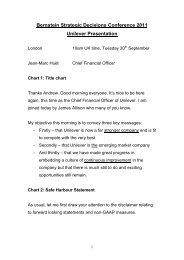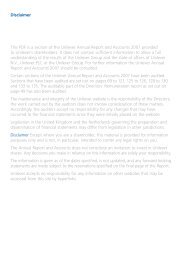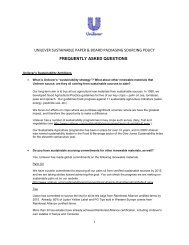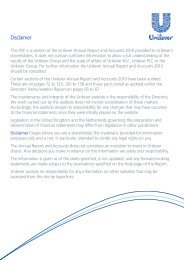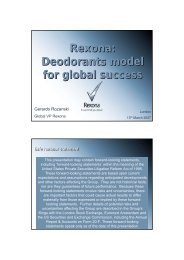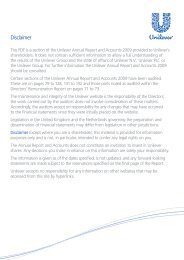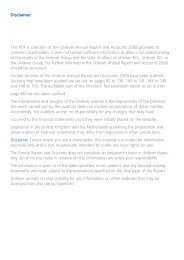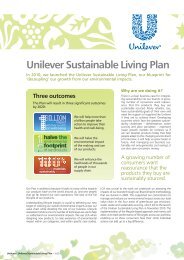Remuneration report - Unilever
Remuneration report - Unilever
Remuneration report - Unilever
Create successful ePaper yourself
Turn your PDF publications into a flip-book with our unique Google optimized e-Paper software.
Report of the <strong>Remuneration</strong> Committee<br />
(continued)<br />
Vested award<br />
(% of original conditional<br />
TSR peer group ranking award that will vest)<br />
12th to 21st 0%<br />
10th or 11th 25%<br />
8th or 9th 50%<br />
5th to 7th 100%<br />
3rd or 4th 150%<br />
1st or 2nd 200%<br />
Peer Group:<br />
Altria Kao<br />
Avon Lion<br />
Beiersdorf L’Oréal<br />
Cadbury Schweppes Nestlé<br />
Clorox Orkla<br />
Coca-Cola Pepsico<br />
Colgate Procter & Gamble<br />
Danone Reckitt Benckiser<br />
Gillette Sara Lee<br />
Heinz Shiseido<br />
Kraft will replace Altria and Kimberly-Clark will replace Gillette in<br />
the peer group.<br />
Share Matching Plan (linked to the annual incentive)<br />
The Share Matching Plan enhances the alignment with<br />
shareholder’s interests and supports the retention of key<br />
executives. In addition, the necessity to hold the shares for a<br />
minimum period of three years supports the shareholding<br />
requirements set out on page 55.<br />
As mentioned earlier, the Executive Directors receive 25% of their<br />
annual incentive in the form of NV and PLC shares. These are<br />
matched with an equivalent number of matching shares. The<br />
matching shares will vest after three years provided that the<br />
underlying shares have been retained during this period and the<br />
Executive Director has not resigned or been dismissed.<br />
The <strong>Remuneration</strong> Committee considers that there is no need for<br />
further performance conditions on the vesting of the matching<br />
shares because the number of shares is directly linked to the<br />
annual bonus (which is itself subject to demanding performance<br />
conditions). In addition, during the three-year vesting period the<br />
share price of NV and PLC will be influenced by the performance<br />
of <strong>Unilever</strong> which, in turn, will affect the ultimate value of the<br />
matching shares on vesting.<br />
Executive Directors’ pensions<br />
Executive Directors are provided with a defined benefit final salary<br />
pension, which is consistent with the pension provision for other<br />
<strong>Unilever</strong> Netherlands and UK employees. The Executive Directors’<br />
arrangement provides a pension of a maximum of two-thirds of<br />
final pensionable pay if they retire at age 60 or later.<br />
56 <strong>Unilever</strong> Annual Report and Accounts 2005<br />
As stated in last year’s <strong>report</strong>, the <strong>Remuneration</strong> Committee<br />
decided that annual incentive would no longer be part of<br />
pensionable pay for new Executive Directors appointed as from<br />
2005. For Executive Directors appointed prior to 2005, annual<br />
incentive is pensionable up to a maximum of 20% of base salary.<br />
Other benefits and allowances<br />
Executive Directors enjoy similar benefits to many other<br />
employees of <strong>Unilever</strong>. For example, like other employees,<br />
Executive Directors are able to participate in the UK Employee<br />
ShareSave Plan, the UK Share Incentive Plan (‘ShareBuy’) and the<br />
All Employee Option Plan, in the Netherlands.<br />
Future developments<br />
The <strong>Remuneration</strong> Committee intends to continue monitoring<br />
trends and changes in the market. It keeps a watching brief on<br />
the continuing alignment between <strong>Unilever</strong>’s strategic objectives<br />
and the reward policy for Executive Directors. The Committee is<br />
continuing its review of the pension arrangements for Executive<br />
Directors during 2006.<br />
Commentary on Executive Directors’ <strong>Remuneration</strong><br />
paid in 2005<br />
The tables on pages 60 to 67 give details of the specific elements<br />
of the Executive Directors’ reward package in 2005. However, the<br />
following additional comments may be helpful in understanding<br />
the various tables. The first sections cover the arrangements for<br />
current Executive Directors, followed by an explanation of the<br />
arrangements for former Executive Directors.<br />
Base salary<br />
Following the AGMs in May 2005, the number of Executive<br />
Directors and their responsibilities changed substantially. The<br />
Committee therefore reviewed base salary levels in light of these<br />
changes. The salary levels were benchmarked against those paid<br />
in other major global companies based in Europe, excluding<br />
companies in the financial sector. The increases for 2005 reflect<br />
the change in the composition and responsibilities of the<br />
Executive Directors, market levels as well as individual and<br />
company performance. The total salary figure compared with that<br />
for last year has reduced significantly as a consequence of the<br />
reduction in the number of Executive Directors. The current<br />
annual base salary levels for the Executive Directors are set out<br />
below:<br />
Executive Director Current annual base salary levels<br />
Based in the UK<br />
Patrick Cescau £935 000<br />
Ralph Kugler £570 000<br />
Rudy Markham £645 000<br />
Based in the Netherlands<br />
Kees van der Graaf €760 000





